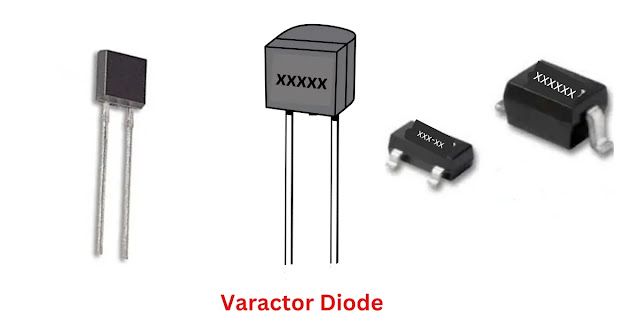Exploring the Varactor Diode working principle, construction and application
A varactor diode, also known as a varicap diode or variable capacitance diode, is a semiconductor device that changes capacitance in response to changes in reverse bias voltage across its terminals. These diodes are widely used in electronic circuits for applications such as voltage-controlled oscillators (VCOs), frequency modulators, and phase-locked loops.
The varactor diode operates on the P-N junction principle, which involves combining a patch of semiconductor material doped with both positive (P-type) and negative (N-type) impurities.

.webp)
In this article, we will discuss the Varactor Diode of some main points like working principle, Construction, its application, Advantages and Disadvantages.
Working principle of Varactor Diode
P-N JunctionThe varactor diode operates on the P-N junction principle, which involves combining a patch of semiconductor material doped with both positive (P-type) and negative (N-type) impurities.
Depletion Region
When a voltage is provided in reverse bias across the P-N junction of a varactor diode, a depletion region is formed. This region lacks free charge carriers, which reduces the diode's overall capacitance.
Capacitance Variation
The capacitance of a varactor diode varies in inverse proportion to the width of the depletion region, which is determined by the magnitude of the reverse bias voltage.

Construction Of Varactor Diode
Semiconductor MaterialsVaractor diodes are typically constructed using semiconductor materials such as silicon (Si) or gallium arsenide (GaAs), depending on the desired characteristics and application requirements.
P-N Junction Structure
The diode's P-N junction structure comprises an area with a high concentration of dopants that serves as the depletion region and achieves the necessary capacitance fluctuation.
Packaging and Physical Characteristics
Varactor diodes are often packaged in small, discrete packages such as surface-mount devices (SMDs) or through-hole packages. They are designed to withstand varying operating temperatures and environmental conditions.
Characteristics of Varactor Diodes
Capacitance vs. Voltage CharacteristicsVaractor diodes exhibit a nonlinear capacitance vs. voltage relationship, with capacitance decreasing as the reverse bias voltage increases.
.webp)
Tuning Range and Frequency Response
These diodes have a large tuning range, making them appropriate for frequency-agile applications.
Each type of diode has specific characteristics and is used for different applications in electronic circuits and systems.
Quality Factor (Q-Factor) Considerations
The Q-factor of a varactor diode refers to its ability to store energy efficiently. Higher Q-factors indicate better performance in resonant circuits and frequency-selective applications.
Applications
Voltage-Controlled Oscillators (VCOs)
Varactor diodes play an important role in VCOs since they control the oscillation frequency dependent on the applied voltage.
Frequency Modulation (FM) Circuits
Frequency Modulation (FM) Circuits
In FM circuits, varactor diodes change the frequency of a carrier signal in response to fluctuating input voltages, allowing for frequency modulation.
Phase-Locked Loops (PLLs)
Phase-Locked Loops (PLLs)
PLLs use varactor diodes to maintain phase coherence between input and output signals, allowing for frequency synthesis and phase control.
Voltage-Controlled Filters (VCFs)
Voltage-Controlled Filters (VCFs)
Varactor diodes are also used in VCFs to change the cutoff frequency and bandwidth of the filter in response to voltage control signals.
Advantages and disadvantages
AdvantagesVaractor diodes are appropriate for a wide range of electronic applications due to their accurate frequency control, compact size, low power consumption, and compatibility with integrated circuits (ICs).
Disadvantages
Disadvantages
They may have nonlinearities, temperature dependencies, and restricted power handling capabilities, making them unsuitable for high-power and high-frequency applications.
Conclusion
Varactor diodes are adaptable semiconductor devices that have distinct capacitance-voltage properties, making them essential components in modern electronic circuitry.
Importance: Their use in voltage-controlled circuits, frequency modulation, and frequency-selective applications emphasizes their importance in enabling advanced communication systems, wireless technologies, and signal processing equipment.
FAQS
What is a varactor diode?
A varactor diode, also known as a varicap diode or variable capacitance diode, is a semiconductor device that changes capacitance depending on the voltage supplied to its terminals.
What is the difference between a Zener diode and a varactor diode?
The main difference between a Zener diode and a varactor diode lies in their functions and operating principles. A Zener diode is designed to maintain a constant voltage across its terminals when operated in reverse breakdown mode, while a varactor diode varies its capacitance based on the reverse bias voltage applied.
What is the function of the varicap diode?
The function of a varicap diode, or varactor diode, is to provide variable capacitance in electronic circuits. This variable capacitance is utilized in voltage-controlled devices such as oscillators and filters, allowing for frequency tuning and modulation based on applied voltages.
What are the advantages of a varactor diode?
Varactor diodes have several advantages, including accurate frequency control, compact size, low power consumption, compatibility with integrated circuits (ICs), and suitability for voltage-controlled applications such as frequency modulation and phase-locked loops.
What is the Zener diode also used for?
In addition to voltage regulation in reverse breakdown mode, Zener diodes are employed in surge protection circuits, voltage references, and clamping diodes to limit voltage spikes in electronic circuits.
Where is the varactor diode used?
Varactor diodes are used in many electronic systems, including radio frequency (RF) circuits, telecommunications equipment, radar systems, television tuners, and wireless communication devices that require frequency tuning and modulation.
Which diode is mostly used?
The most commonly used diode depends on the application. Standard PN junction diodes, such as the 1N4001 family, are commonly employed in rectification circuits. Schottky diodes are popular in high-frequency applications or RF circuits because of their high switching speed and minimal forward voltage loss.
Why is Schottky's diode faster?
Schottky diodes are faster than normal PN junction diodes because of their unique metal-semiconductor junction structure, which reduces forward voltage drop and carrier storage time, resulting in faster switching rates.
What are the types of diodes?
There are several types of diodes based on their construction and properties. Some common types are as follows:
- Zener Diode
- Schottky Diode
- Varactor Diode (Varicap Diode)
- Light-emitting diode (LED)
- Photodiode
- Avalanche Diode
- Tunnel Diode
- Gunn Diode
- PIN Diode


.webp)



Post a Comment